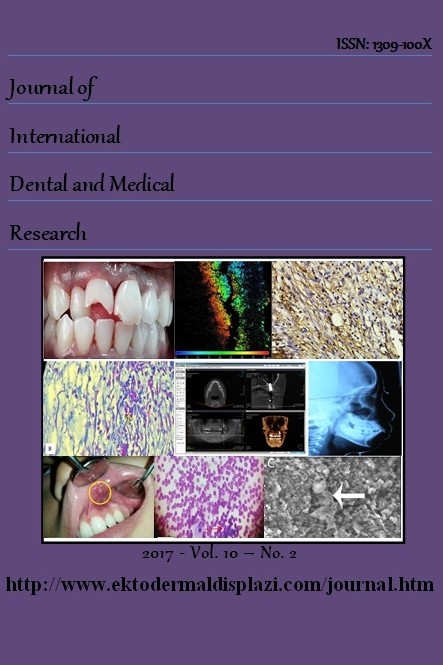Scanning Electron Microscopic Analyses of the Effects of Different Disinfectant Methods on Dentinal Structure
-
Scanning Electron Microscopic Analyses of the Effects of Different Disinfectant Methods on Dentinal Structure
Laser, Ozone, Cavity disinfectants SEM,
___
- Meiers JC, Kresin JC. Cavity disinfectants and dentin bonding. Oper Dent 1996;21(4):153-9.
- Ersin NK, Candan U, Aykut A, Eronat C, Belli S. No adverse effect to bonding following caries disinfection with chlorhexidine. J Dent Child (Chic) 2009;76(1):20-7.
- Brannstr.M, Johnson G. Effects of Various Conditioners and Cleaning Agents on Prepared Dentin Surfaces - Scanning Electron-Microscopic Investigation. Journal of Prosthetic Dentistry 1974;31(4):422-30.
- Schultz RJ, Harvey GP, Fernandezberos ME, et al. Bactericidal Effects of the Neodymium Yag Laser - Invitro Study. Lasers in Surgery and Medicine 1986;6(5):445-48.
- Yamayoshi T, Tatsumi N. Microbicidal effects of ozone solution on methicillin-resistant Staphylococcus aureus. Drugs Exp Clin Res 1993;19(2):59-64.
- Bocci V, Luzzi E, Corradeschi F, Paulesu L, Distefano A. Studies on the Biological Effects of Ozone .3. An Attempt to Define Conditions for Optimal Induction of Cytokines. Lymphokine and Cytokine Research 1993;12(2):121-26.
- Gurgan S, Bolay S, Kiremitci A. Effect of disinfectant application methods on the bond strength of composite to dentin. Journal of Oral Rehabilitation 1999;26(10):836-40.
- Hulsmann M, Rummelin C, Schafers F. Root canal cleanliness after preparation with different endodontic handpieces and hand instruments: a comparative SEM investigation. J Endod 1997;23(5):301-6.
- Sharma V, Rampal P, Kumar S. Shear bond strength of composite resin to dentin after application of cavity disinfectants - SEM study. Contemp Clin Dent 2011;2(3):155-9.
- Martin FE, Nadkarni MA, Jacques NA, Hunter N. Quantitative microbiological study of human carious dentine by culture and real-time PCR: association of anaerobes with histopathological changes in chronic pulpitis. J Clin Microbiol 2002;40(5):1698- 704.
- Arita M, Nagayoshi M, Fukuizumi T, et al. Microbicidal efficacy of ozonated water against Candida albicans adhering to acrylic denture plates. Oral Microbiol Immunol 2005;20(4):206-10.
- Baysan A, Whiley RA, Lynch E. Antimicrobial effect of a novel ozone- generating device on micro-organisms associated with primary 2000;34(6):498-501. in vitro. Caries Res
- Knight GM, McIntyre JM, Craig GG, Mulyani, Zilm PS. The inability of Streptococcus mutans and Lactobacillus acidophilus to form a biofilm in vitro on dentine pretreated with ozone. Aust Dent J 2008;53(4):349-53.
- Gursoy H, Cakar G, Ipci SD, Kuru B, Yilmaz S. In vitro evaluation of the effects of different treatment procedures on dentine tubules. Photomed Laser Surg 2012;30(12):695-8.
- Renton-Harper P, Midda M. NdYAG laser treatment of dentinal hypersensitivity. Br Dent J 1992;172(1):13-6.
- Zhang S, Chen T, Ge LH. Scanning electron microscopy study of cavity preparation in deciduous teeth using the Er:YAG laser with different powers. Lasers Med Sci 2012;27(1):141-4.
- Kalyoncuoglu E, Demiryurek EO. A Comparative Scanning Electron Microscopy Evaluation of Smear Layer Removal from Teeth with Different Irrigation Solutions and Lasers. Microsc Microanal 2013:1-5.
- Zhang S, Chen T, Ge LH. [Scanning electron microscopy was used to observe dentin morphology in primary and permanent teeth treated by erbium: yttrium-aluminum-garnet laser]. Beijing Da Xue Xue Bao 2011;43(5):766-9.
- Soares LE, Martin OC, Moriyama LT, Kurachi C, Martin AA. Relationship between the chemical and morphological characteristics of human dentin after Er:YAG laser irradiation. J Biomed Opt 2013;18(6):068001.
- Stabholz A, Sahar-Helft S, Moshonov J. Lasers in endodontics. Dent Clin North Am 2004;48(4):809-32, vi.
- Dalkilic EE, Arisu HD, Kivanc BH, Uctasli MB, Omurlu H. Effect of different disinfectant methods on the initial microtensile bond strength of a self-etch adhesive to dentin. Lasers Med Sci 2012;27(4):819-25.
- Başlangıç: 2008
- Yayıncı: Ektodermal Displazi Grubu
A Survey on Dental Implant in Use Among UAE and Iranian Dentists
Ayad I.ISMAİL, Musab Hamed SAEED, Sara AFSHARİNİA
Rehabilitation of Open Bite With Diastema Using Zirconia Ceramic Crowns: Case Report
Sedat GUVEN, Tahir KARAMAN, Mehmet UNAL, İhsan Cemal MELEK
Taskin GURBUZ, Fatih SENGUL, Tevfik DEMİRCİ, Munevver CORUH
Oral Health Attitudes and Behavior Among Dental Students in Ajman, United Arab Emirates
Asok MATHEW, Aysha Rashed Ali Al ANSARİ, Ahmed Ali RADAİDEH, Nisha T VARUGHESE
Anesthetic Management of Pregnant Patients with Appendectomy
Feyzi CELİK, Abdullah OGUZ, Zeynep Baysal YİLDİRİM, Abdulmenap GUZEL, Erdal DOGAN, Taner CİFTCİ, İlker Onguc AYCAN
Nisu SWASTİKA, Madhuri GAWANDE, Minal CHAUDHARY, Swati PATİL
The Usage of Low-Dose Lidocaine Fentanyl in Intravenous Regional Anesthesia
Abdulmenap GUZEL, Feyzi CELİK, Öznur ULUDAG, Erdal DOGAN, Celil ALEMDAR, Besir YİLDİRİM
